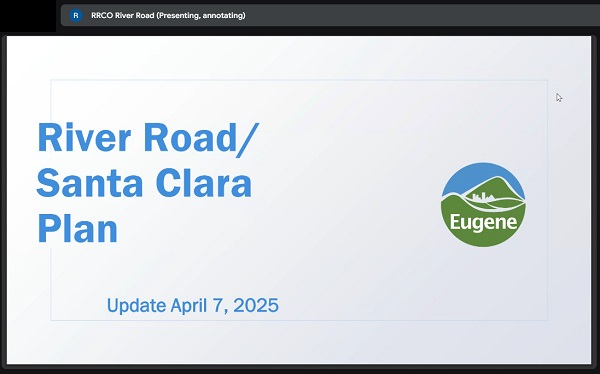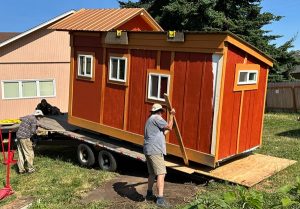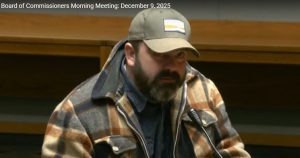River Road asks how city budget cuts will affect neighborhood plans
8 min read
Presenter: With River Road and Santa Clara, the city took a new approach to neighborhood plans. But budget cuts now threaten the neighborhood program, and the city may need a new new approach. At the River Road Community Organization April 7, Kate Perle:
[00:00:16] Kate Perle (Santa Clara Community Organization): Hi, I’m Kate Perle and I’m the chair of Santa Clara Community Organization and I was a co-chair of the neighborhood planning process. I lived on Oakleigh Lane for eight years before I moved to Santa Clara and I’ve been there for 26 years now.
[00:00:30] I think the most important part I can sort of bring to you is a feeling of frustration about: How do we get from planning to implementation in our neighborhood? How do we get to get the resources to see the changes we’ve spent so much time agonizing wordsmithing?
[00:00:47] And I think a big part of that is this annual meeting that we talked about that’s baked into the plan, that our neighborhoods get to have a meeting with the department heads. And maybe it’ll be one meeting with all the different neighborhood plans.
[00:01:01] But then they can inform us about where they’re going, what kind of grant opportunities on their horizon, where do they see opportunities. And we can bring the knowledge of our own plan to that meeting and say, ‘Oh, well, there’s synergy here and so let’s pick this action item.’
[00:01:19] So I know in our community organization I put it to our board that I’m tired of being a catcher. I want us to be a pitcher. You know? Like, we do a great job of reacting to all the different things that come on through different municipalities, through development pressures, through all the different things that happen, but we’re not really great at choosing our path.
[00:01:39] And to do that, we need to look at our neighborhood plan document and pick out some priorities that we think we want to work on.
And so what we did in our neighborhood association was to divide up the five topic areas, try to get two people for each topic area to go through and look at all the action items and try to make a Top 10 list. So then we get 50 action items to work from.
[00:02:04] Presenter: She said although the plans include priority lists, volunteer energy ultimately wins the day. Kate Perle:
[00:02:11] Kate Perle (Santa Clara Community Organization): And so although the document, the actual action plan has all those action items laid out and categorized in all those different ways we talked about and there are priority lists in there, it might not be where we’ve got really good juju going on in our neighborhood right now.
[00:02:29] And if we’ve got energy to do something that isn’t at the top priority, but we’ve got people, that’s where we put energy, because success is what brings participation. If people feel like they can do something and they see a result, they’re more likely to stay involved.
[00:02:44] And really the best opportunity for us is to build capacity in our neighborhood associations, which means more people who want to serve, more people who want to join, more people who want to get involved, and that builds community, which is the basis of the entire neighborhood. So that should be the start of a neighborhood plan.
[00:03:01] So for us, it’s about trying to capture where people have passion. And so that’s, when we sent them away with the action items, we said, ‘Where do you think that you’ve heard somebody else has passion, or you personally are passionate about something, pick that item. Even if it seems impossible, long-term, and very expensive with only government doing it, that’s okay. You’ll, like, pick the passion project, ’cause that’s where we’re going to get started.’
So that’s how we’ve approached it so far.
[00:03:30] Our board had a work session. We all brought back the priorities and that’s as far as we’ve gotten so far. But it starts to whittle things down a little bit. Because it’s paralytic to look at 258 actions and all the ‘blah blah blah blah’ that comes with it and not know how to start, because, yeah. So that’s how I look at it and push my board to look at it.
[00:03:57] Presenter: She said Santa Clara is just starting to work on its process. Kate Perle:
[00:04:02] Kate Perle (Santa Clara Community Organization): I think we had a little bit of fatigue about the whole neighborhood plan. And so I know, personally, I was like, ‘Yeah, I don’t want to think about it. I don’t want to talk about it after all that.’ But now I feel like, ‘Okay, well, let’s go.’
We want to pitch. If we’re going to pitch, we’re going to get up to the plate. And it’s going to require advocacy.
[00:04:21] So the most important thing to know about the neighborhood plan is: That’s just, like, the preplan. The actual plan is us getting up and saying, ‘Okay, well, these are what’s important and this is how we advocate.’ And we ask, like, ‘Who do we go to?’ You know, like, ‘Jason, who do we need to talk about this actually?’ And ‘Cindy, how do we get funding for this?’
[00:04:41] We need to be the people who make it happen by asking for it to happen. (Absolutely.)
[00:04:46] Presenter: From River Road, Jon Belcher:
[00:04:49] Jon Belcher (River Road Community Organization): I’m Jon Belcher. I was the other co-chair, for River Road, in the planning process.
[00:04:54] A lot of our work, we have felt, is on our biggest fears and our greatest hopes. And a way of getting that stuff out there. I’m going to do my hope first, and then my fear.
[00:05:07] The way things work now, in my experience, is I get a call from someone in the Planning, Transportation Planning staff saying, ‘We’re going through this grant and we need, we would like the neighborhood to write a letter of recommendation. Can you get it to us in three days?’
[00:05:25] That whole planning process was done with zero involvement of the neighborhood and we’re just asked to come in the end and say, ‘Yeah, that’s great.’
[00:05:34] My hope was—and Kate kind of keyed on it—is that we will change the process where we talk about what we want, and whichever staff it is talks about what they want. And we actually start that conversation at the beginning, not the end of the process.
[00:05:52] And talking to the execs is not going to get us there. It’s important that we have those discussions with the people who are actually deciding what is going to happen in the city. So my hope is that that is what we’re doing.
[00:06:01] Now my fear.
[00:06:01] We all know that the city has a remand coming up about their budget. And the city has said if the remand succeeds and nothing else changes, there is no neighborhood program. So how are we going to do this planning process…?
[00:06:27] Presenter: From the city of Eugene, supporting the neighborhood program, Cindy Koehler:
[00:06:31] Cindy Koehler (Eugene, neighborhood program): So the neighborhood associations are formally recognized. And that’s through the Neighborhood Organization Recognition Policy. So the neighborhood associations exist. All 23 neighborhood associations exist. That doesn’t go away. What goes away is the support and funding.
[00:06:47] Presenter: Neighborhood associations appear throughout city code, especially Chapter 9, Land Use. The City Council also passed a resolution regarding neighborhoods less than a year ago. It states: ‘Local government must broaden engagement beyond merely asking the public to comment on a process, aiming to actively involve the public in collaborative roles.’
[00:07:10] If the city stops funding the program, neighborhoods will need a new road map for moving into collaborative roles. Jon Belcher asked for a contingency plan.
[00:07:21] Jon Belcher (River Road Community Organization): I would like you guys to develop a contingency plan. We’re going to start down this path, and there’s a way we can actually look through that.
[00:07:29] Presenter: One new volunteer wondered about the learning curve.
[00:07:32] RRCO general meeting attendee: I wasn’t here for this process, but in other similar kinds of processes, there’s a huge learning that happens over the course of time as the groups are discussing all these different areas and developing priorities. So I’m going to step into a group where I don’t have any of that background.
[00:07:51] Presenter: Kate Perle:
[00:07:53] Kate Perle (Santa Clara Community Organization): I wouldn’t worry about not having history about it. If there’s something you’re revved up about, that you want to see change, just show up and say, ‘Hey, does this—,’ you know, you can look and see this is pretty well indexed by topic and if you don’t find it, you could say, ‘Was this ever talked about? Is there anybody else who wants to work on something?’
[00:08:14] You know, the other thing that’s baked in is, we look at our plan every five years and see: Are we meeting our objectives? If we’re not, what do we need to be doing differently? Or maybe our priorities and how will we change?
[00:08:26] Maybe in five years there’s no more cars and all of a sudden there’s all this pavement and think about the bicycles we can make and the street art and who knows? And we get to change! Like, it’s not—It allows us to evolve and become the best possible versions of our neighborhood.
[00:08:43] It just requires us to step up to make that happen.
[00:08:46] Presenter: From the River Road Community Organization, Jan Spencer:
[00:08:50] Jan Spencer (River Road Community Organization): I can tell there’s interest in doing something with this. And the city has to be a part of this too, but I think most of this is kind of up to us.
[00:08:58] Presenter: The 2024 Neighborhood Organization Recognition Policy, the NORP, refers to the city’s neighborhood program more than a dozen times. But without staff or funding, who will fulfill the city’s responsibilities under the NORP? Jon Belcher also wants to know: How will the city engage neighborhoods at the very beginning of the decision-making process, instead of the very end?



